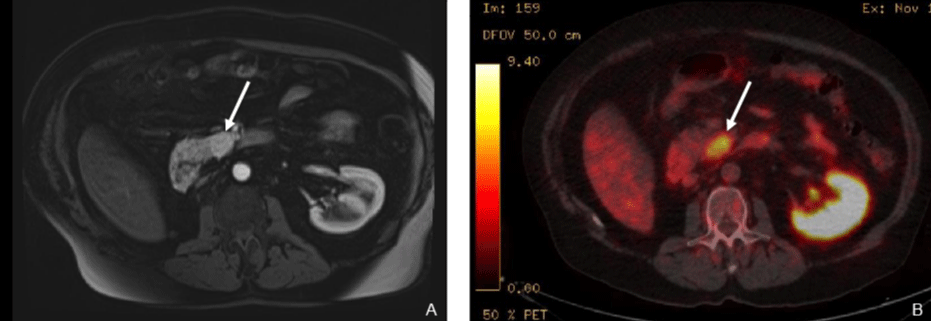
Clinical Image
Austin J Radiol. 2020; 7(2): 1111.
Renal Cell Carcinoma Metastasis Mimicking a Pancreatic Neuroendocrine Tumor on 68Ga Dotatate PET/CT
Abualruz A¹* and Deeb F²
¹Department of Radiology, Wake Forest School of Medicine, USA
²Ross University School of Medicine, USA
*Corresponding author: Abualruz A, Department of Radiology, Wake Forest School of Medicine, 1 Medical Center Boulevard, Winston-Salem, NC 27157, USA
Received: June 16, 2020; Accepted: June 29, 2020; Published: July 06, 2020
Clinical Image
A 72-year-old female presented to the emergency department with a three-day history of epigastric abdominal pain that radiates to the back. The physical exam was unremarkable. Past medical history was positive for recurrent pancreatitis and renal cell carcinoma status post right nephrectomy and adrenalectomy in 1995. Abdomen CT showed a 2.6 x 1.9 cm well-defined hypo attenuating lesion in the pancreatic uncinate process. Further imaging by abdominal MRI with IV contrast demonstrated arterial hyper enhancement and subsequent washout of the pancreatic mass (Figure A), a pattern suggestive of a primary pancreatic Neuroendocrine Tumor (NET). 68Ga DOTATATE PET/CT scan was performed and demonstrated an intense focal radiotracer uptake in the mass (Figure B). However, EUS/FNA was compatible with metastatic renal cell cancer (clear-cell type).

Figure 1: Axial abdomen MRI with IV contrast shows the hyperenhancing pancreatic metastasis (A), which demonstrates intense radiotracer uptake on 68Ga DOTATATE PET/CT (B).
68Ga somatostatin receptor PET/CT is the most sensitive imaging modality for the evaluation of well-differentiated NETs, based on the molecular imaging of Somatostatin Receptors (SSTRs) that are expressed (SSTR type 2 and 5 subtypes). 68Ga-DOTATATE uptake is not specific for NETs, as other malignancies may express SSTRs and can show 68Ga-DOTATATE uptake. SSTR-2 is expressed by tumor cells in primary clear cell RCC and its metastases. Glandular organs like the pancreas and thyroid are typical late metastases of RCC; therefore, 68Ga-DOTATATE is expected to bind to SSTR-2 at these sites.